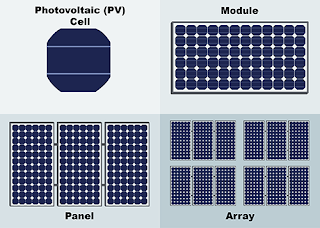Cells, modules, arrays
Photovoltaic cells are connected
electrically in series and/or parallel circuits to produce higher voltages,
currents and power levels. Photovoltaic modulesconsist of PV cell circuits
sealed in an environmentally protective laminate,and are the fundamental
building blocks of PV systems. Photovoltaic panels include one or more PV
modules assembled as a pre-wired, field-installableUnit. A photovoltaic array
is the complete power-generating unit, consisting ofany number of PV modules
and panels
 |
Photovoltaic cells, modules, panels and arrays
|
The performance of PV modules and arrays are generally rated
according to theirmaximum DC power output (watts) under Standard Test
Conditions (STC)
Standard test Conditions are defined by a module (cell) operating
temperature of 25° C
(77F), and incident solar irradiance level of 1000 W/ and under Air Mass 1.5 spectraldistribution.
Since these conditions are not always typical of how PV modules andarrays
operate in the field, actual performance is usually 85% to 90% of the
STCrating
Today’s photovoltaic modules are
extremely safe and reliable products, with minimalFailure rates and projected
service lifetimes of 20 to 30 years. Most majormanufacturers offer warranties
of 20 or more years for maintaining a high percentageof initial rated power
output. When selecting PV modules, look for the product listing(UL),
qualification testing and warranty information in the module manufacturer’s
specifications
Related
equipment’s
- Solar charge controller
Regulates the voltage and current
coming from the PV panels going to battery, prevents battery overcharging, and
prolongs the battery life
- Inverter
Converts DC output of PV panels,
wind turbine into a clean AC current for AC appliances, or fedback into grid
line
- Battery
Stores energy for supplying to
electrical appliances when there is a demand
- Load
Load is electrical appliances that
connected to solar PV system such as lights, radio, TV, computer, refrigerator,
etc
















No comments:
Post a Comment